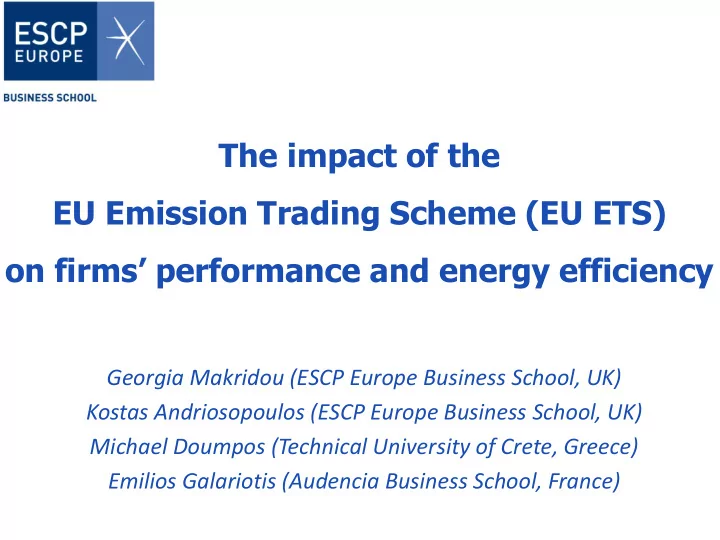

The impact of the EU Emission Trading Scheme (EU ETS) on firms’ performance and energy efficiency Georgia Makridou (ESCP Europe Business School, UK) Kostas Andriosopoulos (ESCP Europe Business School, UK) Michael Doumpos (Technical University of Crete, Greece) Emilios Galariotis (Audencia Business School, France)
Introduction The European Union Emission Trading Scheme (EU ETS) is regarded as the cornerstone of the EU climate policy . Its objective : ‘promote greenhouse gas (GHG) reductions in a cost -effective and economically efficient manner’ (European Commission, 2003). The EU ETS relies on the principle of “cap -and- trade” . It operates in 31 countries (all 28 EU countries plus Iceland, Liechtenstein and Norway). It covers around 45% of the EU’s GHG emissions . 2
Subject of Research This study aims at evaluating the profitability and environmental performance of firms under the EU ETS in a wide EU context since its launch. Profitability = Operating P/L[=EBIT] / Total assets ✓ Economic and Environmental data of a large sample of EU firms covered by the EU ETS are used. 3
Data Dataset (22.972 data) ✓ 25 EU countries (Croatia and Cyprus are excluded due to small number of firms) ✓ 2006 to 2014 ✓ 8 main industrial sectors About 4.185 European firms 4
Data ✓ The industrial sectors and the number of firms per sector ❖ The sectors of Manufacturing and Electricity represent 90% of the sample. 5
Data ✓ Regional distribution of firms Country Country Number of firms Number of firms Austria 82 per country Latvia 9 Belgium 169 Lithuania 3 Bulgaria 71 Luxembourg 8 Czech Republic 219 Netherlands 17 Denmark 4 Norway 25 Country Finland 115 Poland 208 Country France 280 Portugal 162 Germany 595 Romania 132 ISO Code Greece 10 Slovakia 118 Number of firms Hungary 104 Slovenia 53 Ireland 8 Spain 632 per country Italy 654 Sweden 171 United Kingdom 336 6
Variables Variable Explanation CR Current_Ratio =Current Assets / Current Liabilities SR Solvency_Ratio =(Shareholders Funds / Total Assets) * 100 EBITTA EBIT_TO_Tot_Assets =Operating P/L[=EBIT]/Total assets SZ Size =log (Total assets) NETTA No_Empl_TO_Tot_Assets =Number of employees/Total assets ORTTA Oper_Rev_TO_Tot_Assets =Operating revenue / Total assets AF Alloc_Factor =Allowances allocated/Verified emissions VETS Ver_Emiss_TO_Sales =Verified emissions/Sales ❖ Economic data is obtained from the ORBIS database. ❖ Environmental data comes from the European Union Transaction Log (EUTL). 7
Variables Environmental Variables ➢ Alloc_Factor (Allocation Factor) : Allowances Allocated / Verified Emissions o AF > 1 => entity has received allowances that exceed its emissions o AF < 1 => entity either has to buy additional emissions allowances or abate some of its emissions ➢ Ver_Emiss_TO_Sales : Verified Emissions / Sales o Ver_Emiss_TO_Sales = 1 => high amount of emissions o Ver_Emiss_TO_Sales = 0 => low amount of emissions 8
Methodology ✓ Regression analysis in STATA ✓ Four different settings for the variables (M1, M2, M3, M4) o 6 economic variables o 2 environmental variables ✓ Dependent Variable: EBITTA ✓ The value of all independent variables are one unit of time ago compared to the dependent variable 9
Methodology The examined models (M1, M2, M3, M4) Variable M1 M2 M3 M4 ✓ ✓ ✓ ✓ Economic CR (Current Ratio) ✓ ✓ ✓ ✓ Variables SR (Solvency Ratio) ✓ ✓ ✓ ✓ EBITTA ✓ ✓ ✓ ✓ SZ (Size) ✓ ✓ ✓ ✓ NETTA (No_Empl_TO_Tot_Assets) ✓ ✓ ✓ ✓ ORTTA (Oper_Rev_TO_Tot_Assets) ✓ ✓ Environ. AF (Allocation Factor) ✓ ✓ Variables VETS (Ver_Emiss_TO_Sales) 10
Methodology ✓ Model 1 (M1): 11
Methodology ✓ Model 2 (M2): ✓ Model 3 (M3): ✓ Model 4 (M4): 12
Data Analysis Pairwise Correlation Coefficients Note: All correlations are significant at the 1% level except + (p-value = 0.651). ✓ There is no multicollinearity among variables ✓ EBITTA is correlated positively with all economic variables, except NETTA and the environmental variables 13
Results (M1) (M2) (M3) (M4) EBITTA EBITTA EBITTA EBITTA 0.0003 *** 0.0003 *** 0.0003 *** 0.0003 *** Solvency Ratio (SR) 0.0051 *** 0.0048 ** 0.0041 ** 0.0036 * Size (SZ) -0.0020 *** -0.0020 ** -0.0019 ** -0.0018 ** Current Ratio (CR) No_Empl_TO_Tot_Assets -1.177 *** -1.171 *** -1.176 *** -1.167 *** (NETTA) Oper_Rev_TO_Tot_Assets 0.0247 *** 0.0245 *** 0.0236 *** 0.0232 *** (ORTTA) -0.0023 *** -0.0032 *** Allocation Factor (AF) Ver_Emiss_TO_Sales -0.0005 *** -0.0005 *** (VETS) 0.0434 * 0.0460 ** 0.0514 ** 0.0561 ** _cons r2 0.0768 0.0778 0.0779 0.0793 Chi-squared 397.2 404.4 409.7 421.9 14 Note: (* p < 0.1, ** p < 0.05, *** p < 0.01)
Conclusions Both economic and environmental characteristics contribute to the profitability of firms under the EU ETS: ➢ It is mainly affected by the solvency ratio, employment, operating revenue to total assets as well as by the verified emissions to sales and the number of free allocation of emissions allocated to the verified emissions. The information gained through this study sheds light on the effect of the EU ETS at firm’s economic and environmental performance. 15
Next Steps Future research: ➢ enrichment of the data set with firms that are not participating in EU ETS, ➢ analysis on different groups (under- versus over-allocated firms), ➢ a more extensive time period (up-to-date data) ➢ examination of more economic and environmental characteristics 16
Recommend
More recommend